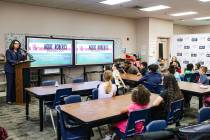Skills gap: It’s your move
Two months ago, the following paragraph started my weekly Career Coach column that has appeared every Sunday in this newspaper for the past nine years.
OK, explain this. Embedded in our national unemployment rate is a startling reality: There are 12 million people unemployed, yet there are 3.6 million unfilled jobs in America. So here are the questions. If that many people are looking for work, how can there be that many unfilled jobs? Wouldn’t you think those jobs would be gobbled up in a day? If employers need 3.6 million workers and those workers are all looking to get hired, what gives?
Good questions then and even better now, as the job market continues its consistent comeback: More than two-thirds of the 9 million jobs lost during the Great Recession are back and the unemployment rate that had been north of 10 is headed south of seven.
And here’s an update. Since mid-December (when that column ran), the numbers have continued to improve. Nationwide, jobs are being created at a rate of more than 6,000 per day, heading to an even brisker rate as hiring continues to pick up in 2013.
But the open jobs remain open.
And if 3.6 million of the 12 million job seekers could fill open, available jobs tomorrow, the unemployment rate would drop from 7.8 percent (at the time of this writing) to 5.5 percent in one wave of a magic wand.
So what really gives?
Here’s the explanation. The Bureau of Labor Statistics calculates its Job Openings and Labor Turnover Rate, measuring open jobs at the end of each month. Last year it averaged 3.6 million with almost no monthly fluctuation — a steady, constant flow of open, available jobs — and they are in all fields. Interestingly, manufacturing, which most people think is dead or comatose, holds up to a half million of those jobs (depending on which research you use).
Again: What gives?
The answer is not that there are no jobs, but it’s also not that employers are hiring, either. It means, and this is the hinge point, that many employers are willing to hire but are not finding candidates with the skills they need.
That’s called the “skills gap.” Simply, employers need more skills than (at least 3.6 million) workers bring to the table. If those skills were there, the jobs would be filled, and employers throughout the land have confirmed that.
So that’s the situation. Or should we say opportunity?
Let’s look at the causes of this skills gap, some examples of the gap, what skills we’re talking about and what you can do to close the gap.
Change, change and more change
Simply, the world is changing quickly and dramatically and taking the job market with it. The changes we’re seeing are not only in business and technology, but in the way a global society interacts in new ways. As a result, employers are facing challenges and competition they never saw before.
“Fifteen years ago, we were just a local optics manufacturer,” said Mike E. (name withheld by request), a plant manager of a privately capitalized, 80-employee, family-owned business. “Our staff of 53 at the time consisted of a five-person executive team, three design engineers, one engineering intern (rotating), three sales engineers, an accounting department of three and a little less than 40 shop floor workers.”
Also, Mike said, “Our only competition was other small regional manufacturers and our only challenge was getting people with sharp technical skills. We all spoke only one language — English, of course.”
But things have changed.
“Now we have to be aware of what’s going on around the world,” Mike said. “We watch currency exchange rates as closely as we watch our machines so that we can maximize deals with international suppliers; we attend trade shows in Europe and Asia; and we now speak five languages among us — a necessity.”
Given all this, what does Mike consider the most critical skills? Technical? Problem solving? Communication? Teamwork? Cross cultural?
“All of them! No question about it,” he said. And which is the most challenging to find? “All of them!”
Does that mean there might be unfilled needs? Jobs they’d like to fill but can’t? “Yes, indeed. Five right now.”
That raises the question: What are you doing about it?
“Not as much as we’d like to,” Mike said. “We’d love to hire pure talent and then train everyone we hire, but we can’t afford to do that. Training is getting more expensive and it’s taking longer, due to the complexity of today’s business, but with shrinking margins, we just can’t afford it.”
The gap is everywhere
This scenario plays out everywhere, in industries like publishing (digital versus traditional), construction and architecture (“green” versus “nongreen”), education (distance learning versus classroom only), pharmaceuticals (protein-based drugs versus drugs based on amino acids or small lipids), and on and on.
Add to that the emerging prominence of languages like Mandarin, Arabic and Spanish; they are three of the five most widely spoken languages in the world. Add the rapid growth of economies like China, Brazil and India; they are the second, sixth, and 10th largest (and will soon be the first, fourth, and fifth, by most estimates).
Consider that few adults remain in the same career field or even industry for the duration of their careers; approximately 75 percent don’t. Add in that education requirements are rising faster than education systems are meeting them; witness the 3.6 million unfilled jobs and the American high school graduation rate that ranks 22nd in the world (US News & World Report, Sept. 11, 2012).
In a nutshell, employers need more skilled people than our education system and our professional development programs are producing. That’s the gap.
Name those skills
OK, exactly what skills are we talking about? Skills fall into two categories of skill sets: hard and soft. Hard skills are the ones you need to do your specific job: machinist, soil sampler, medical technician, online instructor, plumber, linguist and so on. Soft skills are the ones that transcend what you do into how you do it: communication (writing, speaking, public speaking, nonverbal, cross-cultural and listening), problem solving, decision making, team building, leadership, strategic planning, ethics and value setting, and creative thinking.
If there is a clear need for these skills — and an awareness that the gap is widening — why, then is it still going on?
Who did this?
The blame can be laid at the feet of four parties, if we allow ourselves the momentary satisfaction of laying blame before moving on with solutions.
First are employers, who should recognize the out-of-date set of skills in our workplace and accept that a flock of perfectly skilled workers is not likely to drop from the heavens anytime soon. Yet employers have cut back or cut off any long-term training programs. Those who say that it’s the private sector that creates jobs, then, are overlooking the private sector’s new responsibility: to help build a more up-to-date workforce. But it’s not happening.
Second is the education system, both secondary and higher, where the realization has come late that it was not adequately preparing a nation of students for the future. Community colleges, however, are where the most progress is now, but much more must be done.
Third is the government, which must do more to intercede. If the private sector is stubbornly refusing to do what this nation critically needs — train its workforce — then who will? Someone has to promote the common good, and the government, which in the last four years has begun to step up, is the one to do it.
Fourth is the job seeker. Given the current state of affairs, the only one who can take the first step and do something about this now is the one to whom this means the most: the job seeker. And the smart job seeker will see this as an opportunity, career professionals say.
WHAT ARE YOU GOING do?
Here’s what you should be doing, given that education requirements have been rising over the last decade.
n Commit that you will be a lifelong learner. Whether it’s your next degree, certificate(s) or professional training and development classes, it’s the new reality. And you must never stop.
n Community colleges have taken the lead on this, expanding their degree and certificate offerings and gearing them to specific industries and occupations. Four-year colleges are following suit. Examples range from health care technicians to accounting assistants to sustainability engineers (the “green” revolution).
Many programs are now being organized around concentrated dialogue between employers and schools. In essence, schools are saying, “Tell us your skills requirements and we’ll do our best to develop them.” And employers are saying, “Here’s what we need; build them and we will hire them.”
Although that’s going on, it’s your responsibility to jump in and commit. Proof lies in the fact that, with 12 million manufacturing jobs in the United States, there are only 18,000 apprenticeships.
n Online learning facilitates this process, whether from a community college, university or industry association. Keep in mind, though, that online courses from traditional institutions are most desirable.
Jessica B. has a degree in communications and previously worked as an editorial assistant for a midsize publisher. In the economic downturn, and given the wane in traditional publishing, she lost her job.
“I had to make an honest assessment of where my profession was going, but it wasn’t easy,” she said. “Painful was more like it.”
Despite her success at her job, four months passed before she realized she lacked some desirable skills.
So Jessica signed up for courses at her community college, including digital publishing and website development. She also placed an ad on Craigslist looking for freelance editing, copy editing, proofreading and writing. She got assignments.
With new skills and added experience — and updated resume in hand — Jessica headed out into the job market once again. Did it make a difference?
“Eight weeks later,” she said, “I started my new job at an Internet publisher that had previously passed me over!”
Jessica had closed the skills gap.
Obstacles
Certainly the road to closing the skills gap is not completely paved. Some obstacles you may face — but can realistically overcome — are:
n Money. However, financial aid is available and, at community college rates, this becomes affordable.
n The age myth and fitting in. College is no longer just for the recent high school graduate. In fact the median age is nearly 27. So sit down and get comfortable in your courses. You’re not alone.
n Scheduling. This is where distance learning plays big. You can manage your work, school and family responsibilities in more flexible ways.
n Redefine yourself. Professionally update your resume to reflect your new skills, education and experience.
n Expand your network. As much and as fast as the world is changing, this is mandatory.
Your move
Closing the skills gap is not impossible. It’s also not anyone else’s job but yours.






















